Regional Agriculture and Social Capital after Massive Natural Disasters: The Case of Miyagi Prefecture after the Great East Japan Earthquake
Abstract
1. Introduction
2. Literature Review
3. Research Methods
3.1. Sampling Methods
3.2. Data Analysis Methods
4. Results of Analysis and Discussion
4.1. Questionnaire Response Rate
4.2. Residents’ Situations Regarding the Disaster and Methods of Compensating for Losses
4.3. Changes in Social Capital
4.4. Regression Analysis of the Components of Trust
5. Conclusions
Funding
Institutional Review Board Statement
Informed Consent Statement
Data Availability Statement
Acknowledgments
Conflicts of Interest
References
- Coburn, A.; Spence, R. Earthquake Protection, 2nd ed.; John Wiley & Sons: Chichester, UK, 2002. [Google Scholar]
- Guha-Sapir, D.; Hoyois, P.; Wallemacq, P.; Below, R. Annual Disaster Statistical Review: Numbers and Trends, Centre for Research on the Epidemiology of Disasters (CRED), School of Public Health, Catholic University of Louvain, Brussels, Belgium. 2016. Available online: https://reliefweb.int/report/world/annual-disaster-statistical-review-2016-numbers-and-trends (accessed on 22 July 2023).
- Işık, E.; Kutanis, M.; Bal, İ. Loss estimation and seismic risk assessment in Eastern Turkey. Građevinar 2017, 69, 581–592. [Google Scholar] [CrossRef][Green Version]
- Işık, E.; Sagir, C.; Tozlu, Z.; Ustaoglu, U.S. Determination of urban earthquake risk for Kırşehir, Turkey. Earth Sci. Res. J. 2019, 23, 237–247. [Google Scholar] [CrossRef]
- Aldrich, D.P. Building Resilience: SC in Post-Disaster Recovery; University of Chicago Press: Chicago, IL, USA, 2012. [Google Scholar]
- Partelow, S. Social capital and community disaster resilience: Post-earthquake tourism recovery on Gili Trawangan, Indonesia. Sustain. Sci. 2021, 16, 203–220. [Google Scholar] [CrossRef]
- Iwasaki, K.; Sawada, Y.; Aldrich, D.P. Social capital as a shield against anxiety among displaced residents from Fukushima. Nat. Hazards 2017, 89, 405–421. [Google Scholar] [CrossRef]
- Tsuchiya, N.; Nakaya, N.; Nakamura, T.; Narita, A.; Kogure, M.; Aida, J.; Tsuji, I.; Hozawa, A.; Tomita, H. Impact of social capital on psychological distress and interaction with house destruction and displacement after the Great East Japan Earthquake of 2011. Psychiatry Clin. Neurosci. 2017, 71, 52–60. [Google Scholar] [CrossRef]
- Mayer, B. A review of the literature on community resilience and disaster recovery. Curr. Environ. Health Rep. 2019, 6, 167–173. [Google Scholar] [CrossRef] [PubMed]
- Nakagawa, Y.; Shaw, R. Social capital: A missing link to disaster recovery. Int. J. Mass Emerg. Disasters 2004, 22, 5–34. [Google Scholar] [CrossRef]
- Kawamoto, K.; Kim, K. Efficiencies of bonding, bridging and linking social capital: Cleaning up after disasters in Japan. Int. J. Disaster Risk Reduc. 2019, 33, 64–73. [Google Scholar] [CrossRef]
- Masud-All-Kamal, M.; Monirul Hassan, S.M. The link between social capital and disaster recovery: Evidence from coastal communities in Bangladesh. Nat. Hazards 2018, 93, 1547–1564. [Google Scholar] [CrossRef]
- Castro-Correa, C.-P.; Aldunce Ide, P.; Wyndham Vásquez, K.; Mena Maldonado, D.; Pérez Tello, S. Transformation of social capital during and after a disaster event: The cases Chañaral and Diego de Almagro, Atacama Region, Chile. Nat. Hazards 2020, 103, 2427–2440. [Google Scholar] [CrossRef]
- Rayamajhee, V.; Bohara, A.K. Social capital, trust, and collective action in post-earthquake Nepal. Nat. Hazards 2021, 105, 1491–1519. [Google Scholar] [CrossRef]
- Lee, J.; Aldrich, D.P.; Kiyota, E.; Yasuhiro, T.; Sawada, Y. Social capital building interventions and self-reported post-disaster recovery in Ofunato, Japan. Sci. Rep. 2022, 12, 10274. [Google Scholar] [CrossRef] [PubMed]
- Su, Y. Networks of recovery: Remittances, social capital and post-disaster recovery in Tacloban City, Philippines. Int. J. Disaster Risk Reduc. 2022, 67, 102641. [Google Scholar] [CrossRef]
- Hikichi, H.; Aida, J.; Matsuyama, Y.; Tsuboya, T.; Kondo, K.; Kawachi, I. Community-level social capital and cognitive decline after a natural disaster: A natural experiment from the 2011 Great East Japan Earthquake and Tsunami. Soc. Sci. Med. 2020, 257, 111981. [Google Scholar] [CrossRef] [PubMed]
- Monteil, C.; Simmons, P.; Hicks, A. Post-disaster recovery and sociocultural change: Rethinking social capital development for the new social fabric. Int. J. Disaster Risk Reduc. 2020, 42, 101356. [Google Scholar] [CrossRef]
- Serfilippi, E.; Ramnath, G. Resilience measurement and conceptual frameworks: A review of the literature. Ann. Public Coop. Econ. 2018, 89, 645–664. [Google Scholar] [CrossRef]
- Patel, S.S.; Rogers, M.B.; Amlôt, R.; Rubin, G.J. What do we mean by ‘community resilience’? A systematic literature review of how it is defined in the literature. PLoS Curr. 2017, 9. [Google Scholar] [CrossRef]
- Nguyen, H.L.; Akerkar, R. Modelling, measuring, and visualising community resilience: A systematic review. Sustainability 2020, 12, 7896. [Google Scholar] [CrossRef]
- Clark-Ginsberg, A.; McCaul, B.; Bremaud, I.; Cáceres, G.; Mpanje, D.; Patel, S.; Patel, R. Practitioner approaches to measuring community resilience: The analysis of the resilience of communities to disasters toolkit. Int. J. Disaster Risk Reduct. 2020, 50, 101714. [Google Scholar] [CrossRef]
- Ostadtaghizadeh, A.; Ardalan, A.; Paton, D.; Jabbari, H.; Khankeh, H.R. Community disaster resilience: A systematic review on assessment models and tools, Version 1. PLoS Curr. 2015, 7. [Google Scholar] [CrossRef]
- Narayan, D.; Cassidy, M.F. A dimensional approach to measuring social capital: Development and validation of a Social Capital Inventory. Curr. Sociol. 2001, 49, 59–102. [Google Scholar] [CrossRef]
- Yong, A.G.; Lemyre, L.; Pinsent, C.; Krewski, D. Community social capital and individual disaster preparedness in immigrants and Canadian-born individuals: An ecological perspective. J. Risk Res. 2020, 23, 678–694. [Google Scholar] [CrossRef]
- Salim Uddin, M.; Emdad Haque, C.; Walker, D.; Choudhury, M.-U.-I. Community resilience to cyclone and storm surge disasters: Evidence from coastal communities of Bangladesh. J. Environ. Manag. 2020, 264, 110457. [Google Scholar] [CrossRef]
- Hudson, P.; Hagedoorn, L.; Bubeck, P. Potential linkages between social capital, flood risk perceptions, and self-efficacy. Int. J. Disaster Risk Sci. 2020, 11, 251–262. [Google Scholar] [CrossRef]
- Akbar, Z. Community resilience: Lesson learnt from disaster survivors in Yogyakarta province Indonesia. IOP Conf. Ser. Earth Environ. Sci. 2019, 273, 012036. [Google Scholar] [CrossRef]
- Rivera, F.I.; Settembrino, M.R. Ch. 3: Sociological insights on the role of social capital in disaster resilience. In Disaster Resiliency; Routledge: London, UK, 2012. [Google Scholar] [CrossRef]
- Maulana, I.N.H.; Wardah, T.F. Fostering community resilience through social capital. J. Transform. Gov. Soc. Justice 2023, 1, 1–10. [Google Scholar] [CrossRef]
- Gunderson, L. Ecological and Human Community Resilience in Response to Natural Disasters. Ecol. Soc. 2010, 15, 18. Available online: http://www.jstor.org/stable/26268155 (accessed on 24 July 2023). [CrossRef]
- Imperiale, A.J.; Vanclay, F. Conceptualizing community resilience and the social dimensions of risk to overcome barriers to disaster risk reduction and sustainable development. Sustain. Dev. 2021, 29, 891–905. [Google Scholar] [CrossRef]
- Coles, E.; Buckle, P. Developing community resilience as a foundation for effective disaster recovery. Aust. J. Emerg. Manag. 2004, 19, 6–15. [Google Scholar]
- Gil-Rivas, V.; Kilmer, R.P. Building community capacity and fostering disaster resilience. J. Clin. Psychol. 2016, 72, 1318–1332. [Google Scholar] [CrossRef]
- Pretty, J. Social capital and the collective management of resources. Science 2003, 302, 1912–1914. [Google Scholar] [CrossRef] [PubMed]
- Pretty, J.; Ward, H. Social capital and environment. World Dev. 2001, 29, 209–227. [Google Scholar] [CrossRef]
- Li, Y.; Westlund, H.; Liu, Y. Why some rural areas decline while some others not: An overview of rural evolution in the world. J. Rural Stud. 2019, 68, 135–143. [Google Scholar] [CrossRef]
- Barnes, M.L.; Wang, P.; Cinner, J.E.; Graham, N.A.J.; Guerrero, A.M.; Jasny, L.; Lau, J.; Sutcliffe, S.R.; Zamborain-Mason, J. Social determinants of adaptive and transformative responses to climate change. Nat. Clim. Chang. 2020, 10, 823–828. [Google Scholar] [CrossRef]
- Pakmehr, S.; Yazdanpanah, M.; Baradaran, M. How collective efficacy makes a difference in responses to water shortage due to climate change in southwest Iran. Land Use Policy 2020, 99, 104798. [Google Scholar] [CrossRef]
- Saptutyningsih, E.; Diswandi, D.; Jaung, W. Does social capital matter in climate change adaptation? A lesson from agricultural sector in Yogyakarta, Indonesia. Land Use Policy 2020, 95, 104189. [Google Scholar] [CrossRef]
- Musavengane, R.; Kloppers, R. Social capital: An investment towards community resilience in the collaborative natural resources management of community-based tourism schemes. Tour. Manag. Perspect. 2020, 34, 100654. [Google Scholar] [CrossRef]
- King, B.; Fielke, S.; Bayne, K.; Klerkx, L.; Nettle, R. Navigating shades of social capital and trust to leverage opportunities for rural innovation. J. Rural Stud. 2019, 68, 123–134. [Google Scholar] [CrossRef]
- Bănică, A.; Kourtit, K.; Nijkamp, P. Natural disasters as a development opportunity: A spatial economic resilience interpretation. Rev. Reg. Res. 2020, 40, 223–249. [Google Scholar] [CrossRef]
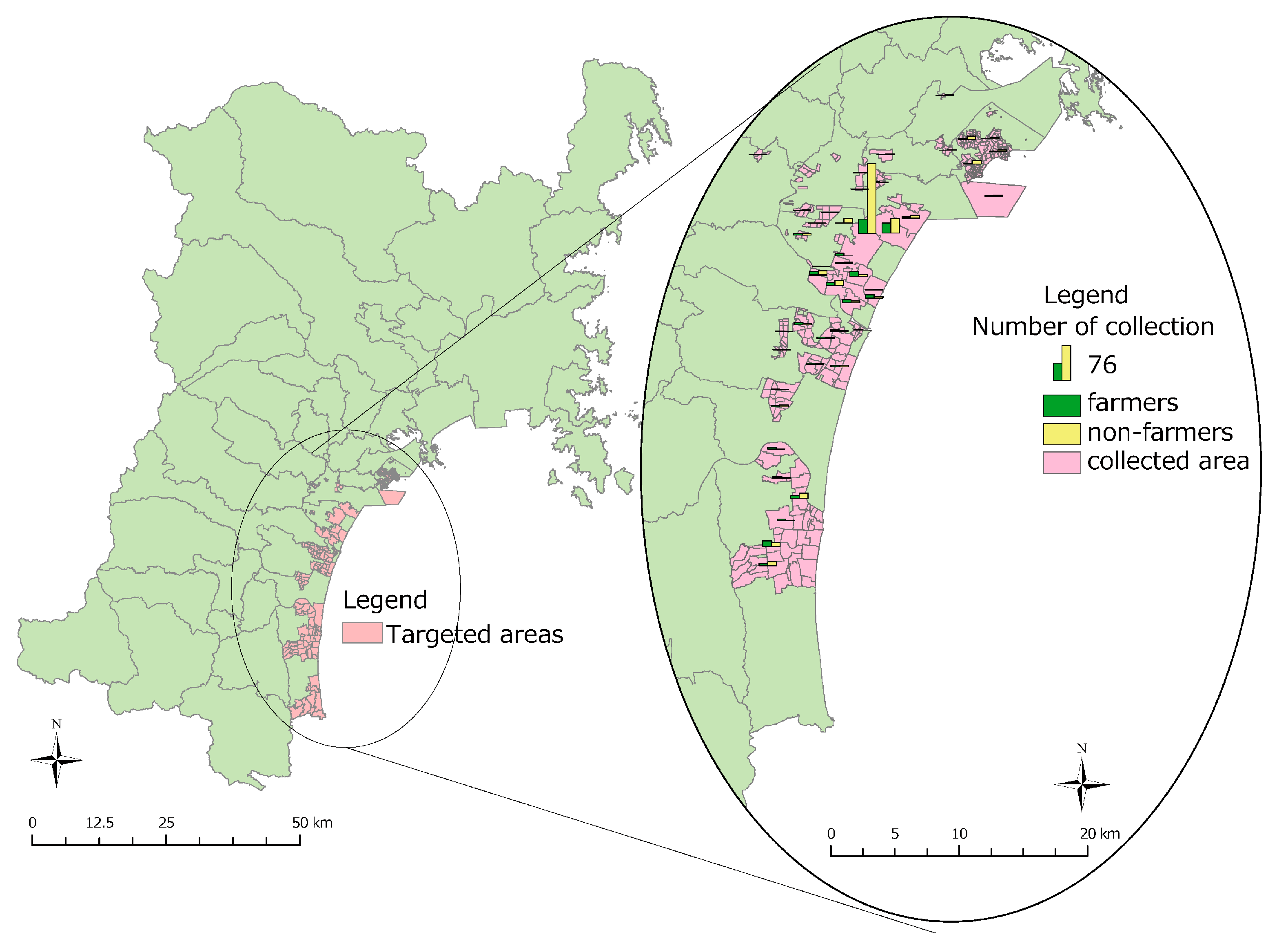
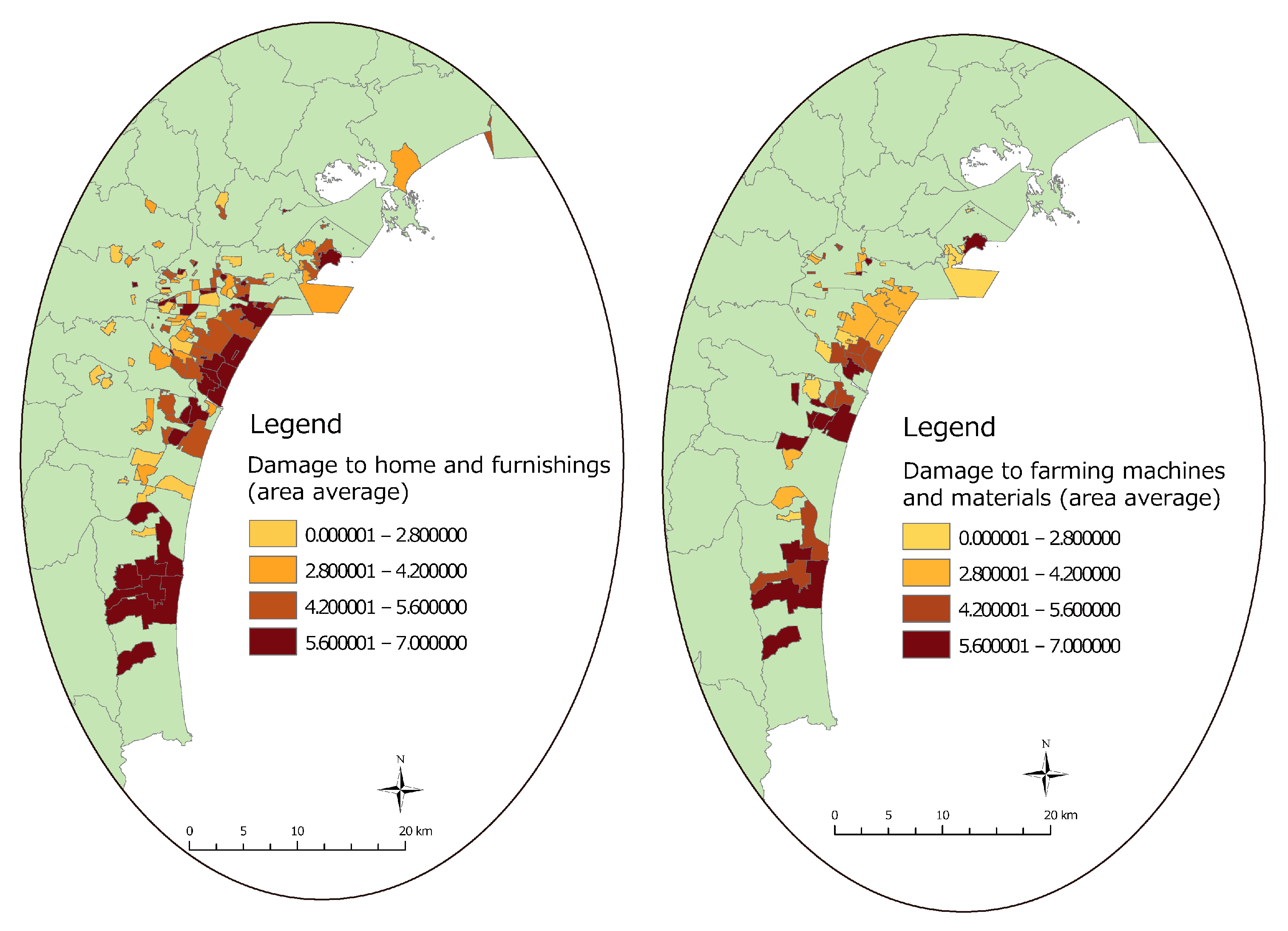


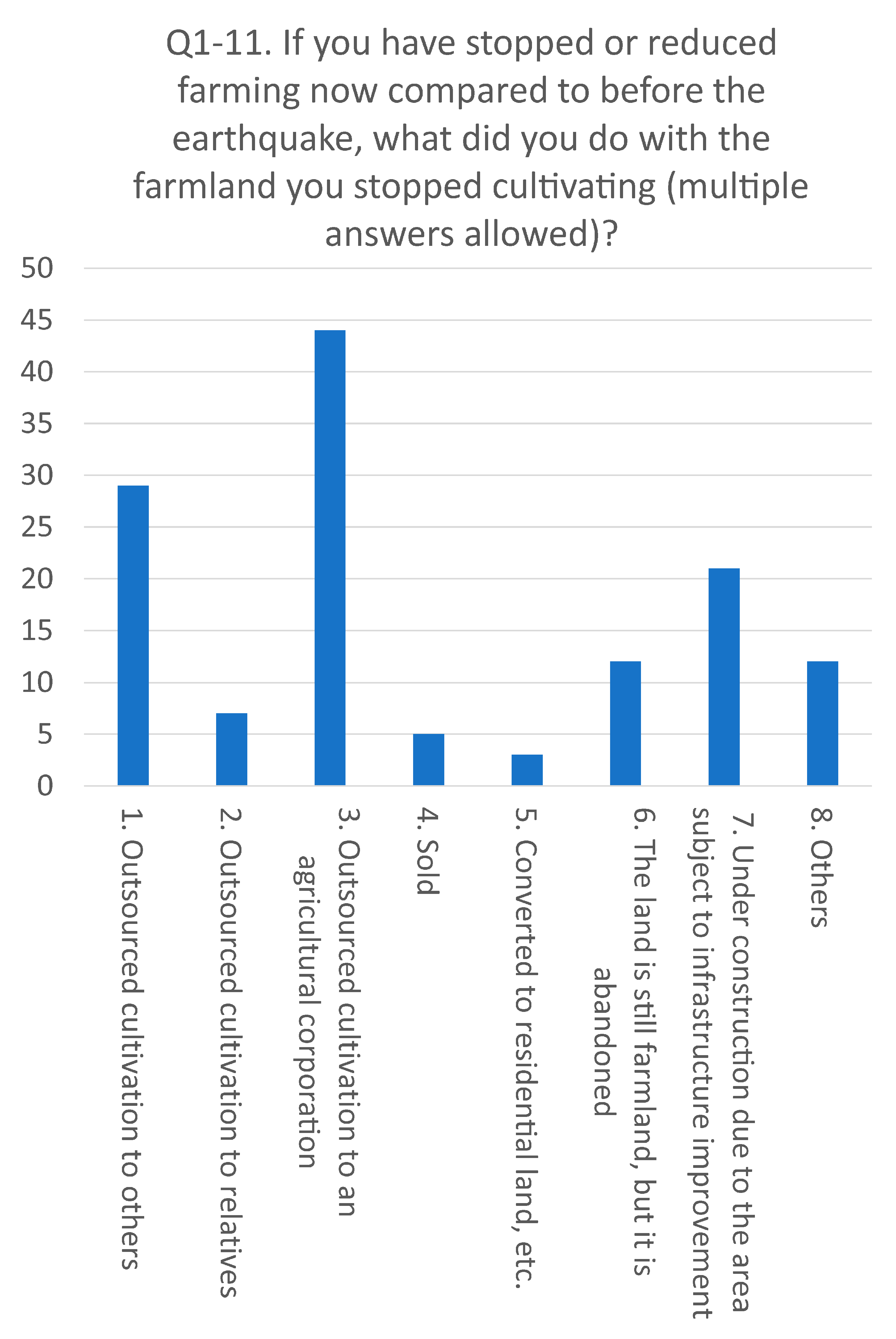
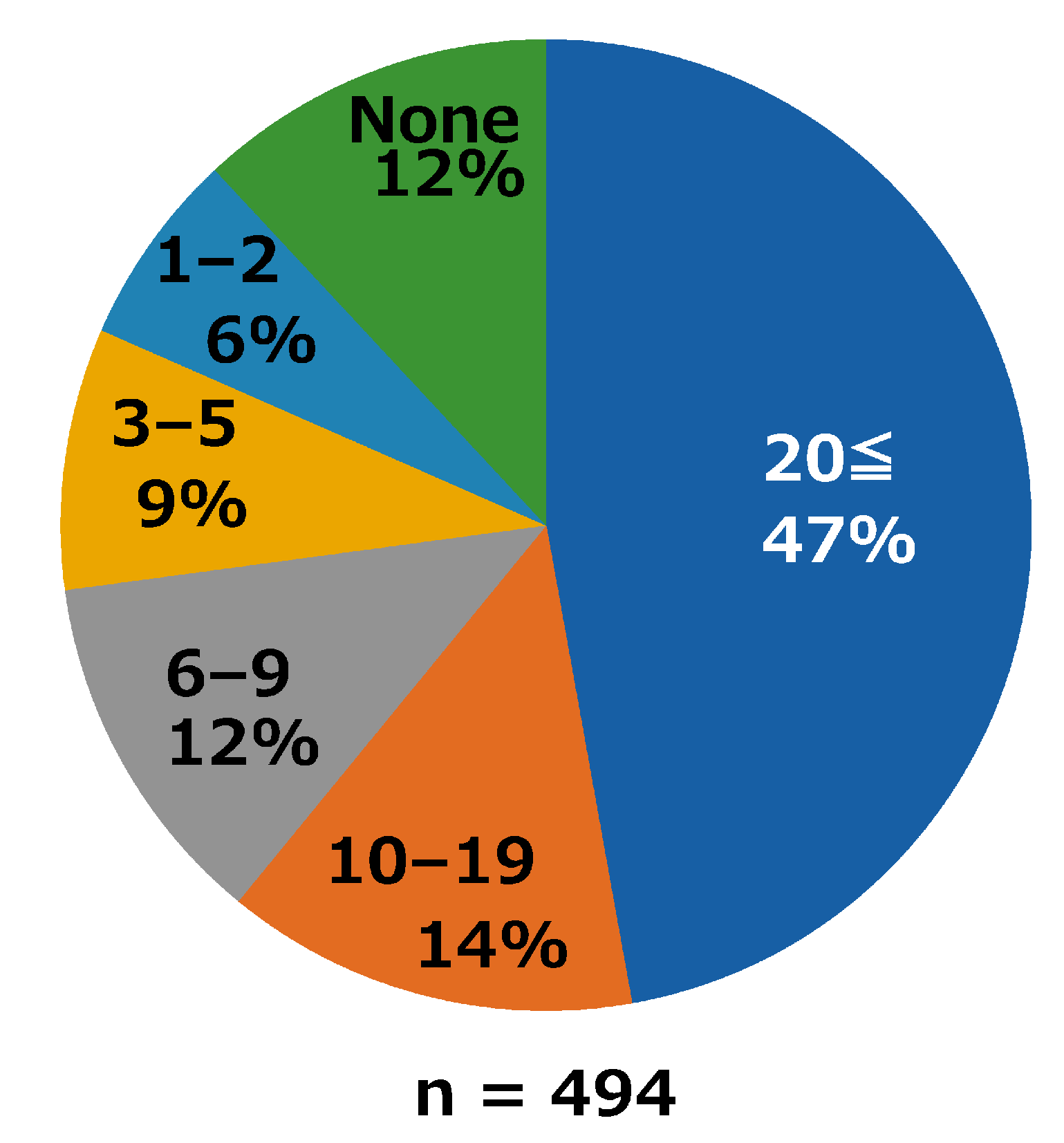
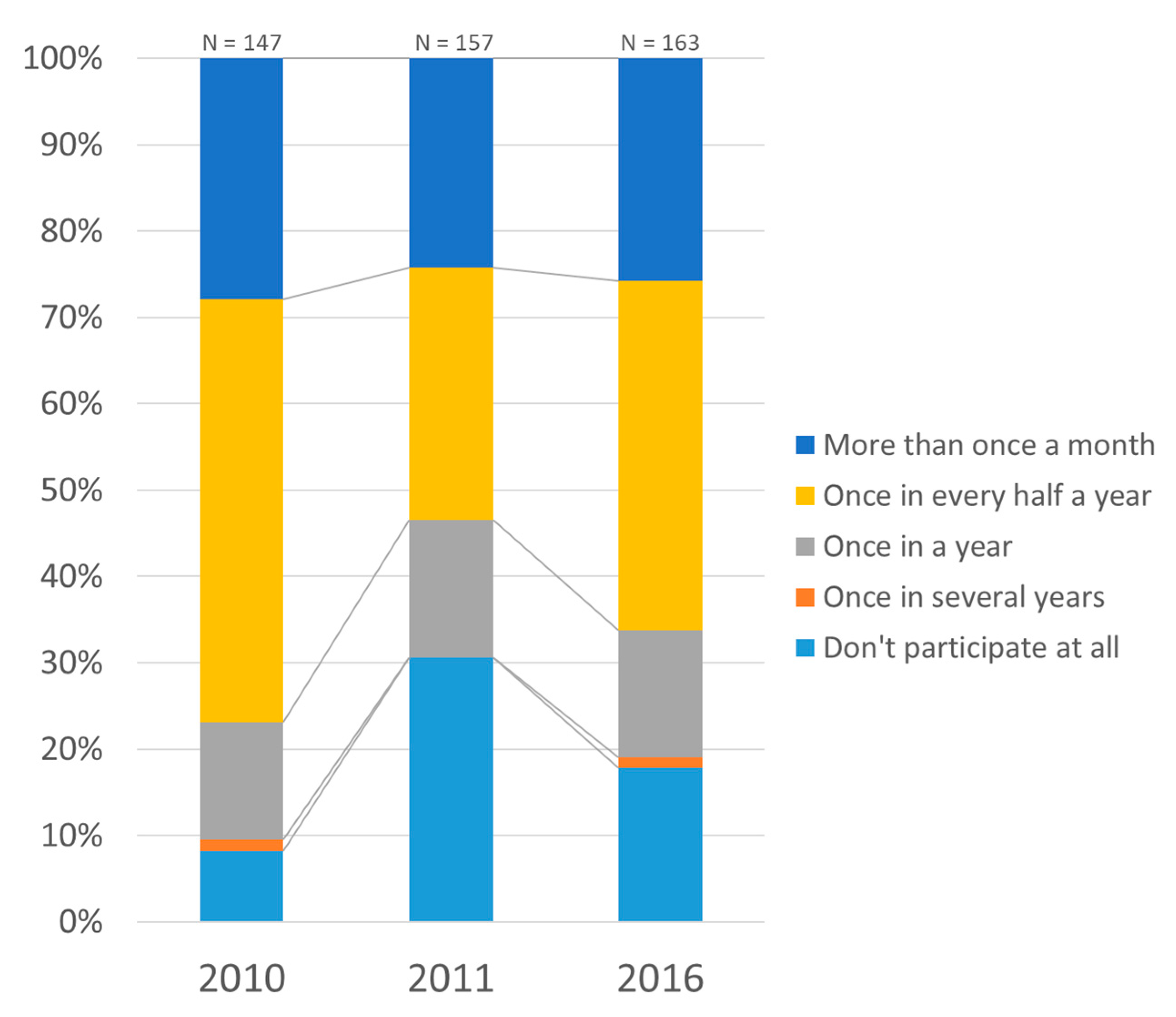
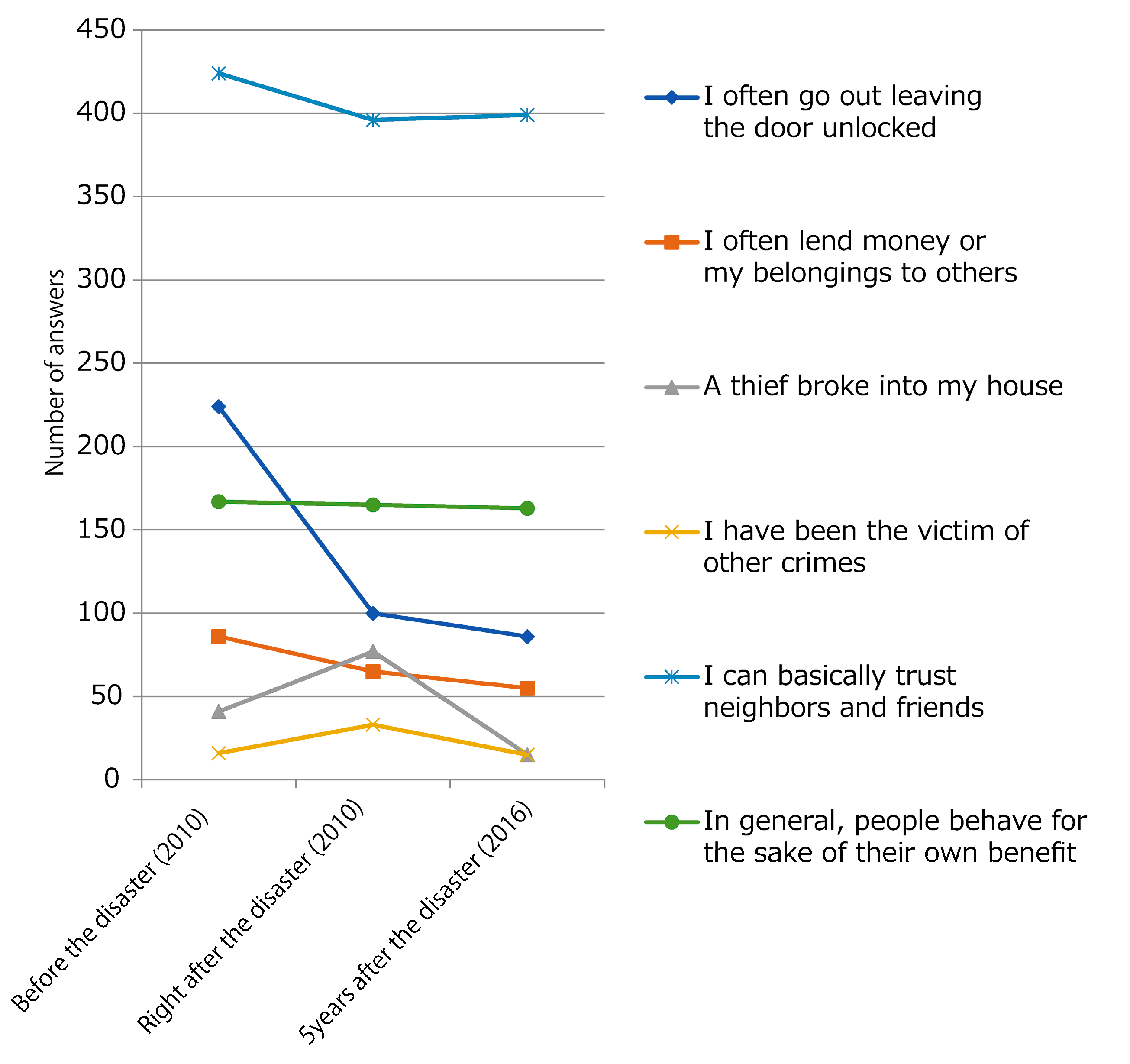

| Survey Distribution Steps | Distribution Details |
|---|---|
| Distribution method | Sent by mail (Town Plus service by Japan Post) |
| Collection period | 3 September 2016–14 April 2017 (98.2% were collected in September 2016) |
| Number of surveys collected (farmers) | 515 (178) |
| Collection rate | 9.99% |
| Targeted areas | Coastal and surrounding areas where the farmer households comprise more than 10% of all the households in Shichigahama-cho, Miyagino-ku, Wakabayasi-ku, Natori-shi, Yamamoto-cho, and Watari-cho |
| Variables | Description |
|---|---|
| Trust | Total score of responses to questions in Table 3 in 2016: 0–4. |
| Gender | Gender of respondents: male = 1, female = 0 |
| Farm | Farmer = 1, non-farmer = 0 |
| Community farm | Participating in community farming (in 2010) = 1, others = 0 |
| Marital status | Single-person household = 1, others = 0 |
| Age | Age of the respondent (in years, 2016) 10s = 1, 20s = 2, 30s = 3, 40s = 4, 50s = 5, 60s = 6, 70s = 7, 80s = 8, 90s and above = 9 |
| Income | Household income in 2015: Less than JPY 1 million = 1, JPY 1–2 million = 2, JPY 2–3 million = 3, JPY 3–4 million = 4, JPY 4–6 million = 5, JPY 6–8 million = 6, JPY 8–10 million = 7, JPY 10 million or more = 8 |
| Move | Different residential zip codes immediately before the 2011 earthquake compared to at the time of the survey response in 2016 = 1, same zip code in 2013 and 2016 = 0 |
| Evacuate | Have evacuation experience = 1, no evacuation experience = 0 |
| Volunteer | As of 2016, volunteering = 1, not volunteering = 0 |
| Hobby | As of 2016, participating in a tea party or other hobby = 1, not participating = 0 |
| Damage | Amount of damage to houses and household goods during the year after the earthquake None (JPY 0) = 1, JPY 10,000–500,000 = 2, JPY 500,000–1 million = 3, JPY 1–3 million = 4, JPY 3.1–5 million = 5, JPY 5–10 million = 6, JPY 10,100,000 or more = 7 |
| Crime | Victims of burglary or trespassing immediately after the earthquake, including at their homes in the affected areas while they were away from home = 1; not victimized = 0 |
| Question | Points |
|---|---|
| I often leave the door unlocked when going out | yes = 1, no = 0 |
| I often lend money or things to friends | yes = 1, no = 0 |
| I can basically trust my neighbors and acquaintances | yes = 1, no = 0 |
| In general, I think people only act in their own best interests | yes = 0, no = 1 |
| Questions | Before the Earthquake | Five Years after the Earthquake |
|---|---|---|
| (Around 2010) | (2016) | |
| 1. The number of days in a month that you participate in community activities, such as neighborhood associations, children’s associations, senior citizen associations, fire companies, etc. | 2.64 days | 2.47 days |
| 2. Average number of volunteer work hours per week (excluding community activities in 1.) | 0.785 h | 1.18 h |
| 3. Hours per week spent attending tea parties and other hobby meetings | 0.867 h | 1.00 h |
| 4. Hours spent talking to family members per day | 2.74 h | 2.77 h |
| 5. Hours spent talking to friends per day | 1.26 h | 1.10 h |
| 6. Average number of people greeted per day | 10.67 | 10.1 |
| 7. Number of friends living nearby | 8.13 | 6.41 |
| 8. Number of days per year spent attending events at neighborhood shrines, temples, and churches | 4.02 days | 4.35 days |
| 9. Number of new friends made at evacuation centers or places you moved to after the disaster | 2.76 |
| Variables | Coefficient | p-Value |
|---|---|---|
| Gender | 0.021 | 0.886 |
| Farm | 0.042 | 0.766 |
| Community farm | −0.225 | 0.61 |
| Single | −0.275 | 0.234 |
| Age | −0.032 | 0.547 |
| Income | 0.126 *** | 0.000 |
| Move | −0.467 *** | 0.001 |
| Evacuate | −0.042 | 0.754 |
| Volunteer | 0.011 | 0.945 |
| Hobby | 0.385 ** | 0.013 |
| Damage | −0.009 | 0.815 |
| Crime | −0.285 * | 0.074 |
| Intercept | 1.523 *** | 0.000 |
Disclaimer/Publisher’s Note: The statements, opinions and data contained in all publications are solely those of the individual author(s) and contributor(s) and not of MDPI and/or the editor(s). MDPI and/or the editor(s) disclaim responsibility for any injury to people or property resulting from any ideas, methods, instructions or products referred to in the content. |
© 2023 by the author. Licensee MDPI, Basel, Switzerland. This article is an open access article distributed under the terms and conditions of the Creative Commons Attribution (CC BY) license (https://creativecommons.org/licenses/by/4.0/).
Share and Cite
Miyama, E. Regional Agriculture and Social Capital after Massive Natural Disasters: The Case of Miyagi Prefecture after the Great East Japan Earthquake. Sustainability 2023, 15, 11725. https://doi.org/10.3390/su151511725
Miyama E. Regional Agriculture and Social Capital after Massive Natural Disasters: The Case of Miyagi Prefecture after the Great East Japan Earthquake. Sustainability. 2023; 15(15):11725. https://doi.org/10.3390/su151511725
Chicago/Turabian StyleMiyama, Eriko. 2023. "Regional Agriculture and Social Capital after Massive Natural Disasters: The Case of Miyagi Prefecture after the Great East Japan Earthquake" Sustainability 15, no. 15: 11725. https://doi.org/10.3390/su151511725
APA StyleMiyama, E. (2023). Regional Agriculture and Social Capital after Massive Natural Disasters: The Case of Miyagi Prefecture after the Great East Japan Earthquake. Sustainability, 15(15), 11725. https://doi.org/10.3390/su151511725







